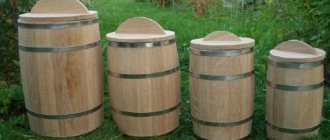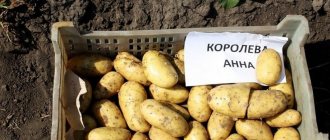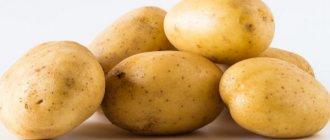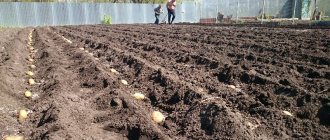Large harvest at the dacha
Of course, when starting to grow crops, a farmer dreams of a successful and large harvest.
However, not everyone knows how to grow a good harvest of potatoes that would be the envy of their neighbors in their summer cottage. In reality, taking care of the harvest is not a tricky matter; it is only advisable not to forget about your plantings and monitor them in a timely manner. For example, if you have already planted potatoes, but suddenly frost hits, you need to go to the dacha as soon as possible to hide the beds under plastic film and any other woven material that would protect the soil and seeds from freezing and death. In general, it is worth noting:
- The further you live from your dacha, i.e. The less opportunity you have to come to the dacha in a short time at any time, the later you should start planting potatoes.
Much depends on the region of your residence and its characteristics; in some places potatoes are planted as early as April, and in others closer to mid-May. The first harvest is obtained by mid-June - early July. Anyone can plant potatoes; much in this matter will depend on the planting method you choose:
- The classic shovel method. The most familiar option for Russian people and more developed. If the groundwater is close to the soil surface or the soil itself is quite dense, but you should not plant potatoes deeply, literally 5 cm deep will be enough. If the soil is light and there are no problems with groundwater, you can plant potatoes to the depth of a shovel;
- Using a walk-behind tractor. An excellent method for planting potatoes if you have a large plot of land. Otherwise, you will get more tired of changing the wheels and guides for the walk-behind tractor in order to create new beds, spread out potatoes, bury beds, etc. But you can’t handle a large plot manually without a walk-behind tractor;
- Under straw and hay. This option is suitable for less arid regions that are not prone to fires from drought and scorching sun. As a result, with minimal effort, you can grow good, large potatoes and in fairly large quantities.
In general, potatoes love air very much, which is why it is necessary - so do not try to dig seed potatoes as deep into the soil as possible. This is what our parents and our grandfathers have always done, but the fact is that it will be a mistake if you do not want to get an early potato harvest, even if it is small. In addition, seedlings must emerge quickly, which will affect the size of the crop. What other information about growing potatoes did you get from your ancestors?
- “You can cut potato tubers in half to save seeds and get more yield.” In fact, you should not do this, otherwise the cut seeds may rot or become diseased. If you have very dry soil and you don’t have the opportunity to water it abundantly, then this option may well work.
- “Store-bought potatoes are bad, they are stuffed with all sorts of chemicals.” Absolutely, but this does not mean that potatoes are harmful to health. The fact is that modern summer residents also use growth stimulants to obtain a larger harvest or chemicals to protect potatoes from pests.
You should also not forget about the biggest scourge of the potato field - the Colorado potato beetle. Unfortunately, it is found in any area, and the best way to get rid of it is constant struggle! And how to grow a large harvest of potatoes without forgetting about caring for them? It will be necessary to spray the tops, collect beetles by hand, and feed the soil for protection. In specialized stores, purchase proven and safe pest control products and use them.
Rules for selecting potato planting material
Many inexperienced gardeners mistakenly believe that seed potatoes should be selected in the spring immediately before planting. However, experienced agronomists strongly recommend choosing it in the fall. Pay attention to the bushes when they are blooming. Mark those that bloom actively and intensely. Mark the best and most powerful plants with ribbons or dig pegs near them.
When to Harvest Potatoes
The surest sign indicating that a vegetable crop is ripe is the appearance of the tops. When the bush withers and dries, the growth of tubers will stop, so you can begin harvesting from the beds. After the tops dry, the gardener has 3 weeks to harvest the potatoes.
You can dig up one bush to check the readiness of the tubers. Their skin should be dense and not peel or peel when rubbed.
How to dig up potato tubers
You need to be very careful when digging potatoes intended for planting next spring. It is recommended to do this only with a pitchfork. This way the risk of damaging the tubers is minimized. After digging, they are inspected for rot and damage.
You need to choose those bushes that had at least seven potatoes. Of these, 4 should weigh at least 100 grams (after winter, the vegetable may shrink by 10-15 grams). If you dug up a bush with active greenery and there are 4-5 potatoes in it, it is better to discard such seed material. There is an obvious degeneration of the variety.
It is not recommended to leave potatoes that were in the bush along with rotten tubers for planting. This is fraught with rotting of healthy tubers.
Selected healthy potatoes are placed in the sun for 2-3 hours. Then they are transferred to a dry place under a canopy.
How to prepare seed material for storage
For half a month, potatoes are stored in a dry place with access to the sun. The air temperature should remain at 19-20 degrees. Every day, agronomists change the location of the tubers (it must dry and warm up on all sides).
Seed potatoes should not be eaten as they contain toxic substances - solanines. A small portion will not cause severe intoxication of the body, however, a person will feel a general malaise.
The main advantage of such planting material is that it is stored for a longer period, and rodents practically do not attack it.
Growing large potatoes
Every summer resident wants not only to grow good potatoes, but also to get a harvest from large tubers. To do this, you don’t need to go to an area of high radiation, it’s just important to approach the landing process correctly. For example, you cannot make a mistake about the time of planting potatoes, but there is no exact and correct date for this; a lot depends on your region of residence.
- Potatoes are planted quite early, but not before the soil in the garden has warmed up to a depth of 10 cm;
- The approximate permissible soil temperature at this time should not fall below 8 degrees Celsius for 3-4 days;
- Approximately, in the middle zone, potatoes are planted from late April to early May. As a rule, during the May holidays people go to their dachas to not only relax, but also to plant potatoes.
There is a folk sign that symbolizes the beginning of warmth without frost. If you are afraid that the potatoes will freeze after planting. Then focus on the following:
- When the birch leaves become the size of a penny, you can plant potatoes in damp soil!
In fact, if you want to grow a good potato crop, then you need to competently approach the preparatory process of growing and here is what is important in this case:
- Find the perfect potato variety for your soil type. To do this, you will have to spend time, or in the first year of growing, use different varieties of potatoes: plant them separately and write down where, which variety, in order to get complete information about the results. In the future, use only a more successful variety with large potato tubers;
- Use only the best seed potatoes. You should not save at this stage if you want to get a large harvest. If you want, you can use seeds from the previous harvest, or you can purchase them from a trusted seller or neighbor in the area. The main thing here is the right variety and high quality of seeds;
- Grow crops correctly, i.e. follow a certain technology in this process. This also applies to preparing seeds for planting, preparing the soil, as well as caring for planted potatoes on the site.
So, the easiest way to grow large potatoes is in loose soil, so don’t forget to dig them up in the fall. However, when planting potatoes under straw, no digging is required, and the harvest can be enviable! Don’t forget to also hill up the rows every 1.5 weeks, fertilize the soil, water the holes, and also spray the plants against diseases, pests and insects, to which potato tubers and their tops are so often susceptible.
Secrets of a good harvest
All summer residents are more interested not in exactly how to grow potatoes in the country, but in how to get a big and large harvest. The secrets in this matter are simple, and every person can cope with it:
- Proper preparation of potatoes and selection of seed tubers for planting;
- Good care of potatoes during their ripening period;
- Protection of potato tops from pests.
As you can understand, everyone can have the secrets of a large harvest. Much also depends on the soil on your site, as well as on the type of potato you use for planting. If the soil in the garden is not fertile, it must be fertilized so that the harvest can please you. To begin with, in the documents for the site, carefully read what type of soil you have. If there is no such data, it is worth finding out about it from neighbors or through special research. This will be very useful to you in the future to grow a high yield of potatoes!
So, remember the main points:
- Sandy soil warms up quite early; it does not tend to be extremely wet. However, growing vegetables in such soil is very difficult. For this reason, potatoes are not often grown on it, or they first help the land in this matter. You can plant potatoes on such land relatively early, already in April, only in this case it is worth covering the beds with film to protect them from drying out, sun and frost. The calculation of fertilizers is based on 1 sq.m.: a mixture of clay soil and humus or peat in the amount of one bucket is suitable.
- Clay soil contains about 80 percent clay, the rest is sand. Such soil does not allow water and fresh air to pass through well, which makes it difficult for plants to ripen and develop. Areas with such soil are difficult to warm up, which is why it is late, so you should start planting potatoes no earlier than May 5-9. To grow a potato crop in such conditions, fertilize the soil with humus or peat, or a peat-manure mixture in the amount of one bucket per 1 sq.m. Important: if you are not sure how the soil was fertilized before you, you should increase the size of fertilizers to 1.5-2 buckets per 1 sq.m.
- Peat soil has its drawbacks, for example, it does not conduct heat received from the sun well, and therefore does not warm up well. As with clay soil, peat soil requires later attention for summer cottage work. It is not advisable to grow crops in such lands; you will waste more time on it. However, if you have no choice, you need to well fertilize the potato plot with mixtures useful for such soil. It can be humus, clay, or simple river sand at a consumption of 1 bucket per 1 sq.m.
Is it possible to grow a bucket of potatoes from a bush?
They also grow two buckets per bush, depending on which bucket. Seriously, increasing the yield from a potato plant is a completely doable task.
Read our recommendations carefully; you will reap a record harvest even from a small plot.
What does productivity depend on?
The productivity of any crop depends on its care - this is the golden rule of the gardener. Even the most prolific potato varieties can be ruined if these rules are not followed.
Caring for the crop consists of:
- in the selection of seed material;
- in preparing potatoes for planting;
- in proper planting, watering, weeding and properly selected fertilizers.
Potato planting rate per 1 ha
The traditional method of growing potatoes is to plant the tubers in rows. The width of the rows is 70-90 cm, the distance between plants in the row is 25-45 cm.
Expert opinion Ivan Yuryevich Filatov, private farmer for more than 30 years For example, on one hundred square meters (a plot of 10 × 10 m in size), with a distance between rows of 70 cm, approximately 14 rows are placed (taking into account the fact that the outer rows on the plot are located indented from border). If the distance between plants is 40 cm, then you can plant 25 tubers in a row. Therefore, 350 potatoes are required to plant 1 hectare. With a weight of seed tubers of 70-80 g, the total mass of planting material will be 27-28 kg.
Of course, in practice, seed tubers are calibrated with high accuracy only in specialized stores. Therefore, if planting material is taken from your own harvest, then it is necessary to take into account the error (as well as possible damage to the seeds in storage) and leave the seeds at approximately 28-29 kg per hundred square meters.
When marking the same plantation scheme, the hectare size will be 142 furrows, each with 250 bushes. This will take 35,500 seed tubers with a total weight of about 2.84 tons (in practice 2.8-2.9 tons).
Planting density: what is it and how to determine what it affects?
When the potato rhizome has enough nutrition and space, we can talk about optimal planting density. At high density, the tubers receive a minimum of nutrients and grow small and deformed.
Article on the topic: Potato crop rotation at a summer cottage - 2 basic techniques
There are standards for optimal planting density for regions:
- For the Northern and Northwestern regions - 50-55 thousand bushes per hectare.
- For the Central and Southern regions - from 45 to 55 thousand bushes per hectare.
For mid-season potatoes, a density of 30-40 cm is recommended, for early varieties - 20-35 cm, for late varieties - 40-50 cm.
Accordingly, planting density will also affect the planting rate. With small planting material and an interval of 20 cm, the consumption per hundred square meters will increase significantly. With an average rate of 25-30 kg per hundred square meters, you will need 35 kilograms (approximately 700 pieces). When planting the same tubers at intervals of 30 cm, approximately 20 kilograms will be required.
The optimal planting density for potatoes is considered to be planting at a distance of 35 cm. This will provide the so-called nutrition area - about 70x20 cm. It allows root crops to receive maximum nutrition with sufficient free space, which means, with proper care, a decent harvest.
If you know how to calculate the average consumption rate of planting material, you can learn to use the available land as productively as possible. If there is a shortage of seeds, you can use the method of planting in shares. In this case, calculations will be made according to the principle described above, but in pieces.
If you find an error, please select a piece of text and press Ctrl+Enter.
How many potato seeds are needed per 1 hectare?
The main goal of growing seed potatoes is maximum yield with the smallest tuber size. This is important because small seed potatoes are more expensive than large ones. A high yield with a small number of tubers is achieved only due to a large number of these tubers. This is achieved due to greater planting density. For example, in the Netherlands the optimal density is 25 - 45 base stems per square meter.
The optimal density of bushes is selected depending on the variety, soil type, length of the growing season (class), the price of seed potatoes in general and a certain size of seed material. Ask your trading partner (or whoever you buy your seeds from) to select the best density for the selected variety, taking into account all local conditions. If the bush does not completely cover the leaves with soil, then during hot periods there is a risk of secondary growth. As a result of this germination, secondary tubers with a very low dry matter content are formed, and the primary tubers are deformed.
Having determined how many seed crops need to be planted per hectare to achieve the required plantation density, the distance between bushes in a row is easily pink. Let's say you want to have 35 thousand plants per hectare. This means that the area of one plant will be 10,000 m2 / 35,000 = 0.286 m2. If the distance between rows is 75 cm, the distance between bushings in a row will be 2.860 cm2 / 75 cm - 38 cm.
What determines the number of potatoes on a bush?
On average, two dozen potatoes are formed on a bush, but there can be five or forty of them.
Back in the eighteenth century, the Russian agronomist Bolotov counted one hundred potatoes on one bush. If everything is clear with the size of root crops, it depends on the variety and suitability of the soil, then it is more difficult to increase the number of potatoes. Of course, the variety plays a big role. Also, the number of tubers directly depends on the looseness of the soil. In heavy clay, there is simply nowhere for roots to develop. There is a certain dependence of the number of tubers on the number of trunks in the bush. The more branched and lush the plant, the more active photosynthesis is, the more nutrients it stores in the tubers. For more trunks, more eyes are needed. Traditional methods of selecting and preparing seed material are completely justified in this case.
How many potatoes can be harvested from 1 hectare on average?
So, what is the average potato yield per hectare? The size of the seed potato greatly influences the development of the plant. However, with the same number of stems per square meter, this will ultimately lead to higher yields. In terms of kilograms of tubers, relatively smaller tubers develop relatively more stems than larger ones. In some variants, this difference is up to 40 percent. Therefore, for example, in Dutch seed tubers measuring 28-35 mm are larger than tubers measuring 35-45 mm.
The size of seed tubers significantly influences plant development. Because larger potatoes contain more nutrients.
Determine how many tubers are in 1 kg to calculate the total weight of potato seeds you will need. This way you will know how many seed potatoes are needed to maintain your chosen planting density.
Potato yield depends on many factors. We evaluate the harvest not by the area of the plot, but by the amount of planting material. From one to five. If a summer resident planted one bucket and dug up five buckets, that’s good.
Potato planting dates
Agronomists constantly argue about this and cannot decide what is better for potatoes - drought or frost.
Planting early potato varieties allows you to get an early harvest and protect it from possible pests. Usually, early potatoes are harvested before the late blight outbreak and the peak of the Colorado potato beetle activity. This happens at the end of July - beginning of August. At this time, all 4 generations spread on the land plots. However, the disadvantage of such early planting is the poor keeping quality of the resulting crop. It is very difficult to preserve planting material until next spring - the tubers begin to sprout, which is why you need to break off the sprouts. All this reduces yields.
How many potatoes can you harvest from 1 acre?
You can get more than 200 kg (say 4 bags) if you buy elite seeds, monitor each bush more often, feed it. The yield of potatoes largely depends on the condition of the soil and its fertility. In well-fertilized, unpolluted soil, without wireworms and mole crickets, from 1 potato you can dig up 3 to 5 huge potatoes. For example, Zhukovsky early potatoes yield from 100 square meters from 200 to 450 kilograms. The Red Cat potato variety yields from 450 to 600 kilograms per 1 hectare, that is, 100 square meters.
But, nevertheless, not a single variety will survive and every year there will be less harvest if the land does not rest and is not fertilized.
The answer to this question depends on many circumstances and specific factors:
- Firstly, from the land on which these potatoes will grow.
- Secondly, it depends on the type of potatoes planted.
- Thirdly, from the weather conditions and characteristics of the area, even from a height above sea level.
A specific indicator is in the Tambov region, on black soil, Sineglazka, under favorable conditions, produces about two bags, i.e. about 70-80 kilograms.
How many kg do you collect from 1 hundred square meters? More than 100 kg Less than 100 kg
Calculation for large areas
How much lime should be added to the soil on the site
The rate of planting potatoes for the fields of agricultural enterprises or farms is calculated in a similar way. However, generally accepted measures are used to simplify calculations. There are tables compiled by employees of agricultural enterprises. So, approximately 60,000-65,000 tubers are planted per hectare. If the weight of one tuber is 80 g, then the consumption rate is 4800 kg/ha. If converted to centners, then this is 48 centners per 1 hectare.
Potato planting rate
Potatoes in fields measured in hectares are planted in rows with a large distance between them (from 70 to 100 cm). This is necessary so that equipment, such as a tractor, can pass through. It is used to plant and harvest crops.
How to increase potato yield
To get closer to the desired harvest volumes per hectare, a number of conditions must be met.
- It is necessary to carefully select a variety: it must be suitable for the conditions of your region and tested for yield. Even the most highly profitable varieties, but not resistant to drought conditions, will not give the expected results; you plant them in the southern steppe regions of our country.
- Another important point is that do not grow potatoes in the same place for several years: in this way you can degenerate very quickly. Either we change the landing site, or we change the planting material.
- As you know, potatoes love loose soils that allow air and water to pass freely, so if you plant them on a clay plot, you should not expect any decent return. Sandy soil mixtures that are generously fertilized with organic fertilizer and allow good oxygen circulation will work well for crops.
- But the most important point is, of course, high-quality soil fertilization. Fertilizing can be done with both organic (bird droppings, humus or compost) and mineral fertilizers.
How to increase potato yields in your garden plot
What could be easier than growing potatoes in the garden? This is perhaps one of the most common vegetable crops in Russia. No wonder it is called “second bread”. Even if there is nothing else, you will survive the hungry time on potatoes and will not lose weight.
Read on Dacha6.ru:
To get the maximum possible potato harvest from your garden plot, you can use some methods that are actively discussed on dacha forums. Let's look at them in more detail:
- More main stems on a potato bush mean higher yield. The main potato stems are formed from the eyes of planting root crops. It is on them that the main part of the future harvest appears. It is advisable to remove branches from the main stems so that they do not distract the plant’s strength.
- You can plant peas in the planting hole along with potatoes (5 peas per hole). Such a neighbor will not only have a positive effect on the overall yield, but will also discourage the Colorado potato beetle from potato beds.
- Timely watering is extremely important even for such an unpretentious crop as potatoes. But it has the greatest effect on the future harvest 3-4 weeks after emergence. It is at this moment that the tubers are actively forming and filling, so make sure that the soil during this period remains moist, but not waterlogged.
- The longer the potato leaves stay green, the higher the final yield. Green potato leaves absorb sunlight, which, thanks to the process of photosynthesis, is converted into energy so necessary for the growth and development of tubers. The root system will become more powerful, which means the plant will receive more nutrients and moisture from the soil.
- Many summer residents plant potatoes in pre-dug trenches, the bottom of which is already covered with mown grass. After planting, the tubers are also covered with a layer of mown grass. According to the assurances of many summer residents, this method increases the yield several times, and besides, there is no need for periodic weeding and hilling.
- Watch for leaves to dry out. When the potato bush completes its life cycle and the tubers are formed, the plant begins to dry from the bottom up. This is a normal trend. However, if you notice that the top of the head has begun to dry out, and even ahead of time, then it is necessary to establish the cause of the disease and take timely control measures. The reason often lies in plant disease with late blight, rhizoctonia, or an attack by a pest - the Colorado potato beetle, wireworm. Timely measures will help reduce losses and save most of the harvest.
- Treatment of potatoes with a solution of copper sulfate (50 g per bucket of water) a few weeks before harvest will help increase potato yields. This will cause the tops to wither faster, transferring the nutrients and moisture accumulated in them to the tubers, which will begin to ripen more quickly.
- In the second half of summer, treat potato bushes with a solution of magnesium chlorate (200 g per 10 liters of water). As a result, ripening will accelerate and overall yield will increase. Treat at the rate of 1 bucket of working solution per 1 sq.m.
- During the flowering period or immediately after its completion, treat potato bushes with a superphosphate solution (10 liters for every 1 hundred square meters). To do this, the granules should be infused in water for 8 hours, after which everything is thoroughly mixed until they are completely dissolved. Superphosphate has a slowing effect on the development of tops, resulting in more moisture and nutrients remaining in the tubers.
How many potatoes can you harvest from 1 acre? What is the yield?
To answer this question, you need to take into account several important points:
- the composition of the soil in which vegetables will be grown;
- variety of planting material;
- weather;
- climate features of the region.
The average potato yield per acre is 200 kilograms. These results can be improved if you purchase elite varieties and feed the bushes.
The yield of root crops largely depends on the fertility and condition of the soil. If it is rich, well fertilized, and there is no mole cricket and wireworm, you can get up to five large tubers from one bush. With proper care, the potato yield from 1 acre can reach up to 450-600 kg.
For example, when planting the early Zhukovsky variety, you can harvest 200-450 kg of potatoes from 1 hundred square meters, and even more - up to 600 kg for the Red Cat. Some farmers claim that they manage to exceed even these volumes and obtain up to a ton of root crops.
It is also worth considering that if the soil is not fertilized and does not rest, the amount of vegetables collected from the site will decrease annually. Therefore, attention is paid to crop rotation. Vegetables should be grown in different areas every year. Do not forget about organic and mineral fertilizers, systematic pest control and regular watering. These factors directly affect the result.
Ways to increase productivity
To exceed the average yield values and get the maximum number of potatoes per hundred square meters, you can use methods that increase this indicator. The results of crop cultivation are positively influenced by:
- quality of “seed” potatoes;
- proper preparation of planting material;
- use of special technologies;
- compliance with crop rotation;
- proper organization of watering;
- soil nutritional value and fertilizing volumes;
- organizing activities to eliminate pests and diseases.
Planting frequency has a direct impact on yield. The greater the distance between the planting holes, the more generous the potato harvest will be given to you. The bushes will receive maximum light, nutrition and moisture, and the tubers will be larger and more numerous. Farmers also note that the North-South direction of the ridges increases yield by 10% relative to the West-East orientation.
Special techniques
To increase productivity, several special techniques have been developed:
- Mittlider method. Planting is done in beds 1.5 m wide with a distance of 1 m. Earthen mounds are organized around the planting to retain moisture. Regular watering and three-time application of fertilizers make it possible to achieve high potato yields per hectare - 55 tons.
- Gülich method. 1 m2 is allocated for each plant. The planting hole is filled with humus, and a large root crop is planted in it, top down. High-quality watering is organized; when shoots appear, soft soil is poured into the center of each plant, and the stems are pulled to the sides. As it grows, the manipulation is repeated, which helps to form a multi-tiered bush that produces up to 16 kg of tubers.
- Dutch technology. High-yielding Dutch varieties are used for planting; the beds are located in the North-South direction. Embankments with a height of 25 cm are organized with a distance of 80 cm, into which planting material with a diameter of 3-5 cm is planted. 2 weeks before harvesting, the tops are removed, which makes it possible to increase the size of the tubers. The technique allows you to remove 2 kg of potatoes from a bush.
- Lavrov's technique. The method, which originated in the Tula region, involves harvesting 3 potato crops from 1 acre, which is ensured by repeated planting of early ripening varieties (late April, early June, early August). Subsequent batches are planted in row spacing 80 cm wide approximately 2 weeks before the planned digging of the first planting. This technique allows 100 kg of planting material to produce 450 kg of yield per 1 sq.m.
As an experiment, you can try each method in practice to find out which one will be the most convenient, least labor-intensive and productive for you.
Selection of productive varieties
To get the maximum yield from an acre allocated for potatoes, you need to choose high-quality seed, focusing on popular and productive varieties. Thus, the most popular among gardeners and professional farmers are:
- early Red Scarlet (450-600 kg per hundred square meters);
- early Timo (350-600 kg per hundred square meters);
- early Zhukovsky (300-600 kg per hundred square meters);
- early Bellorosa (320 kg per hundred square meters);
- mid-early Nevsky (600 kg per hundred square meters).
By choosing high-yielding varieties for planting, characterized by resistance and early ripening, you will achieve significant success even when cultivating just one hundred square meters of land allocated for potatoes. To ensure such indicators, you need to follow the recommended agrotechnical rules and properly care for the crop.
Feeding and watering
The yield of potatoes is affected by the regime of watering and fertilizing. As a rule, fertilizers are applied to planting holes and mixed with compost. Good effect on potato yields:
- ammonium nitrate, which serves as a source of nitrogen, which is important for the development of green mass;
- Superphosphate, the granules of which gradually dissolve and supply the crop with substances important for the formation of tubers;
- Super compost, which increases the nutritional value of the soil due to the work of beneficial bacteria.
If you wish, you can also fertilize during the periods of flowering and tuber formation, but at this stage you should select fertilizers without nitrogen. Otherwise, active growth of tops will occur to the detriment of yield.
You will learn clearly about the planting method and the use of fertilizers at this stage from the video:
Many gardeners believe that atmospheric precipitation is enough for potatoes and do not pay due attention to planting. However, regular watering during periods of growth and flowering has a positive effect on crop yield, tuber size and their characteristics.
Varieties with which you can achieve such yields
There are several varieties of potatoes with maximum yield. They differ in shape and in the number of tubers on the bush, and the tubers themselves vary in weight. It is quite possible to collect a bucket of potatoes from a bush with these varieties.
- Bellarosa - a variety bred in Slovakia, large, highly starchy with white, crumbly, quickly boiling pulp. Bellarosa has a brownish rind. The variety requires regular watering, this is the only way the potatoes will reach a weight of 500-600 g. From 1 sq. m get 5.5 kg of potatoes.
- Idaho - Every fast food chain orders it. The large tubers of this variety are perfectly smooth and elongated. Idaho potatoes have an atypical flavor and are nutritious and starchy. The variety is resistant to diseases and is early ripening. From 1 sq. m get 6 kg.
- Gala is an early variety, the bush is only 50 cm high, but the weight of 5-6 tubers per bush reaches 400 g, the rest are twice as small. From 1 sq. m get 7 kg.
- Rosara is a variety with multiple tubers - up to 30 pieces, weighing 150 g. The variety is resistant to diseases and starchy. However, the Colorado potato beetle loves him very much. From 1 sq. m get 4-4.5 kg.
- Udacha is a productive, large-fruited variety. The average weight is 180 g, there are about 25 tubers per bush. Harvest from 1 sq. m - about 10 kg.
- Slavyanka is a variety from Ukraine. Large tubers weighing up to 1 kg. It is unpretentious to the soil, not starchy, but has an inexpressive taste. Used as feed. Harvest from 1 sq. m – 3-3.5 kg.
Reference. Seed material of elite varieties, which in the first seven years will produce only large, tasty potatoes, is created in special laboratories of agricultural firms. They are sold as mini tubers with sprouts. With this material you can collect a bucket from a bush.











